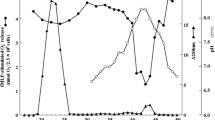Abstract
The effect of benzydamine on stimulus-dependent respiratory burst activity and enzyme release was tested in human neutrophils, monocytes and monocyte-derived macrophages. Establihsed anti-inflammatory compounds, indomethacin, phenylbutazone and bufexamac, were tested for comparison. Care was taken to avoid cytotoxic or cytolytic concentrations of the test compounds, and their effect on release of lactate dehydrogenase was also tested.
Release of specific and azurophil granules contents were induced in human neutrophils by A23187, PMA and fMLP with and without cytochalasin B pretreatment. Benzydamine inhibited stimulus-dependent release of vitamin B12-binding proteins, a marker for the specific granules, in a concentration-dependent fashion. By contrast, phenylbutazone and bufexamac were practically inactive. The effect of benzydamine on exocytosis of azurophil granules was tested in cytochalasin B-pretreated neutrophils. Benzydamine, again in contrast to the two reference anti-inflammatory compounds, inhibited release concentration-dependently also under these conditions. The concentration of the compound which inhibited exocytosis by 50% was 30–100 μM in normal and 3–10 μM in cytochalasin B-treated neutrophils.
The effect of benzydamine and reference compounds on the respiratory burst was tested by assaying for superoxide formation in neutrophils and H2O2 formation in mononuclear phagocytes. Benzydamine was inactive on neutrophils and inhibited slightly the burst response of monocytes and macrophages. Two reference compounds, bufexamac and phenylbutazone, were generally more active. The strongest inhibitory effect was that of phenylbutazone on fMLP-stimulated cells. Benzydamine lacked activity receptor of formylated chemotactic peptides.
The profile of activity of benzydamine shown in these experiments on human phagocytes suggest that this compound may act therapeutically by decreasing the release of enzymes and other granule constitutents from stimulated neutrophils.
Similar content being viewed by others
References
R. Lisciani, P. Scorza Barcellona andB. Silverstrini,Researches on the topical activity of benzydamine, Eur. J. Pharmac.3, 157 (1968).
R.J. Flower, H.S. Cheung andD.W. Cushman,Quantitative determination of prostaglandins and malondialdehyde formed by the arachidonate oxygenase (prostaglandin synthetase) system of bovine seminal vesicles, Prostaglandins4, 325 (1973).
S. Moncada, P. Needleman, S. Bunting andJ.R. Vane,Prostaglandin endoperoxide and thromboxane generating systems and their selective inhibition, Postaglandins12, 323 (1976).
S.A. Saeed, P.A. Kendall, N.M. Butt andH.O.J. Collier,On the mode of action and biochemical properties of anti-inflammatory drugs, Biochem. Soc. Tras.7, 655 (1979).
A. Szczeklik andR.J. Gryglewski,Asthma and anti-inflammatory drugs. Mechanisms and clinical patterns, Drugs25, 533 (1983).
P. Gorog andI.B. Kovacs, The alteration of platelet behaviour during various conditions and the effect of anti-inflammatory agents on platelet aggregation and thrombus formation. InInflammation Biochemistry and Drug Interaction, p. 197 (EdsA. Bertelli andJ.C. Houck). Excerpta Medica, Amsterdam 1969.
K. Goto, M. Hisadome andH. Imamura,Effects of tinoridine on stability of rat liver and kidney lysosomes and liver parenchymal cells, Biochem. Pharmac.26, 11 (1977).
B.M. Babior,Oxygen-dependent microbial killing by phagocytes, New Engl. J. Med.298, 659 (1978).
M. Baggiolini andB. Dewald, Exocytosis by morphological characterization of azurophil and specific granules of human neutrophil polymorphonuclear leukocytes, J. Cell. Biol.63, 251 (1974).
C.G. Figdor, W.S. Bont, J.E. Devries andW.L. Van Es,Isolation of large numbers of highly purified lymphocytes and monocytes with a modified centrifugal elutriation technique, J. Immunol. Methods40, 275 (1981).
B. Dewald, M. Baggiolini, J.T. Curnutte andB.M. Babior,Subcellular localization of the superoxideforming enzyme in human neutrophils, J. clin. Invest.63, 21 (1979).
B. Dewald, U. Bretz andM. Baggiolini,Release of gelatinase from a novel secretory compartment of human neutrophils, J. clin. Invest.70, 518 (1982).
J.C. Unkeless, S. Gordon andE. Reich,Secretion of plasminogen activator bystimulated macrophages, J. exp. Med.139, 834 (1974).
W. Ruch, P.H. Cooper andM. Baggiolini,Assay of H202 production by macrophages and neutrophils with homovanillic acid and horse-radish peroxidase, J. Immunol. Methods63, 247 (1983).
C. Dahinden andJ. Fehr,Receptor-directed inhibition of chemotactic factor-induced neutrophil hyperactivity by pyrazolone derivatives. Definition of a chemotactic peptide antagonist, J. clin. Invest.66, 884 (1980).
B. Catanese, A. Grasso andB. Silvestrini,Studies on the absorption and elimination of benzydamine in the mouse, rat, dog and main, Arzneimittel-Forsch.16, 1354 (1966).
Author information
Authors and Affiliations
Rights and permissions
About this article
Cite this article
Baggiolini, M., Mauderli, P., Näf, U. et al. Effect of benzydamine on exocytosis and respiratory burst in human neutrophils and mononuclear phagocytes. Agents and Actions 16, 346–352 (1985). https://doi.org/10.1007/BF01982871
Received:
Issue Date:
DOI: https://doi.org/10.1007/BF01982871




